
Theta Andromedae is a binary star system in the northern constellation of Andromeda. Theta Andromedae, Latinized from θ Andromedae, is its Bayer designation. It is located at a distance of approximately 173 light-years from the Sun, and has an apparent visual magnitude of 4.6. On the Bortle Dark-Sky Scale, this makes it visible to the naked eye from outside urban regions. Based on its motion through space, this system appears to be a member of the Sirius supercluster.

LN Andromedae, also known as HD 217811, HR 8768, is a formerly suspected variable star in the constellation Andromeda. Located approximately 458 parsecs (1,490 ly) away from Earth, it shines with an apparent visual magnitude 6.41, thus it can be seen by the naked eye under very favourable conditions. Its spectral classification is B2V, meaning that it's a hot main sequence star, emitting light approximately with a blackbody spectrum at an effective temperature of 18,090 K.

ζ Coronae Borealis, Latinised as Zeta Coronae Borealis, is the Bayer designation of a double star in the constellation Corona Borealis. The two components are separated by six arc-seconds and share the same Hipparcos catalogue number and Flamsteed designation. Each of the two is also a spectroscopic multiple system, with a total of five stars in the group.

c Puppis, also known as HD 63032 and HR 3017, is a spectroscopic binary star in the constellation Puppis. Its apparent magnitude is 3.61. Located around 347 parsecs (1,130 ly) distant, the primary is an orange-red bright giant or supergiant of spectral type K2.5Ib-IIa or K5IIa, while the secondary, discovered in 1983, is a blue main-sequence star of spectral type B9V. The system is the brightest member of the open cluster NGC 2451, over two magnitudes brighter than every other star in the cluster. As the turnoff point of the cluster is currently around B7, the parameters of the system fit with cluster membership.

WR 148 is a spectroscopic binary in the constellation Cygnus. The primary star is a Wolf–Rayet star and one of the most luminous stars known. The secondary has been suspected of being a stellar-mass black hole but may be a class O main sequence star.

S Cassiopeiae is a Mira variable and S-type star in the constellation Cassiopeia. It is an unusually cool star, rapidly losing mass and surrounded by dense gas and dust producing masers.
QV Andromedae is an Alpha2 Canum Venaticorum variable in the constellation Andromeda. Its maximum apparent visual magnitude is 6.6, so it can be seen by the naked eye under very favourable conditions. The brightness varies slightly following a periodic cycle of approximately 5.23 days.

LQ Andromedae is a variable star in the constellation Andromeda. Its maximum apparent visual magnitude is 6.5, placing it at the limit of the visibility to the naked eye. The brightness, however, drops down to 6.66 with a periodic cycle of roughly 7.44 hours.

AB Andromedae is a binary star in the constellation Andromeda. Paul Guthnick and Richard Prager discovered that the star is an eclipsing binary in 1927. Its maximum apparent visual magnitude is 9.49 but shows a variation in brightness down to a magnitude of 10.46 in a periodic cycle of roughly 8 hours. The observed variability is typical of W Ursae Majoris variable stars, so the two stars in this system form a contact binary.

AD Andromedae is an eclipsing binary in the constellation Andromeda. Its maximum apparent visual magnitude is 11.2, but it shows a decrease of 0.62 magnitudes during the main eclipse and 0.58 during the secondary one. It is classified as a Beta Lyrae variable star with a period of almost one day.

BX Andromedae is an eclipsing binary star in the constellation Andromeda. Its maximum apparent visual magnitude is 8.87. Within a cycle of approximately 14.6 hours, the brightness drops down to a magnitude of 9.53 during the main eclipse, and to a magnitude of 9.12 during the secondary one. It is classified as a Beta Lyrae variable.

CC Andromedae is a variable star in the constellation Andromeda. It is a pulsating star of the Delta Scuti type, with an apparent visual magnitude that varies between 9.19 and 9.46 with a periodicity of 3 hours.
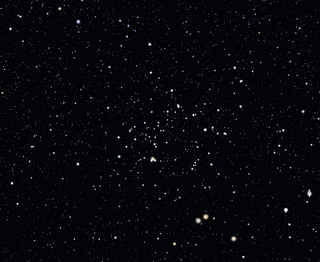
DS Andromedae is an eclipsing binary star in the constellation Andromeda and a member of the open cluster NGC 752. Its maximum apparent visual magnitude is 10.44, but drops down to 10.93 during the main eclipse and to 10.71 during the secondary one.
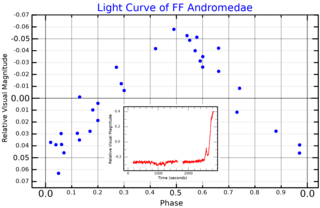
FF Andromedae is a spectroscopic binary in the constellation Andromeda. It has a typical apparent visual magnitude of 10.4, but undergoes flare events that can increase its brightness by about a magnitude.
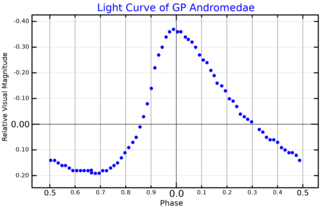
GP Andromedae is a Delta Scuti variable star in the constellation Andromeda. It is a pulsating star, with its brightness varying with an amplitude of 0.55 magnitudes around a mean magnitude of 10.7.

GR Andromedae is a variable star in the constellation Andromeda. Its apparent visual magnitude varies between 6.87 and 6.95 in a cycle of 518.2 days. It is classified as an α2 Canum Venaticorum variable.
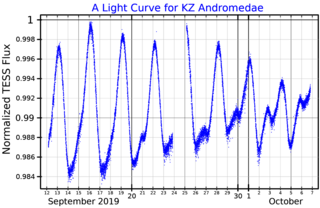
KZ Andromedae is a double lined spectroscopic binary in the constellation Andromeda. Its apparent visual magnitude varies between 7.91 and 8.03 during a cycle slightly longer than 3 days.

QR Andromedae is an eclipsing binary star in the constellation Andromeda. Its maximum apparent visual magnitude is 12.16, but its light curve shows clearly eclipsing events where its brightness can drop to a magnitude of 13.07. This leads to its classification as an Algol variable star.
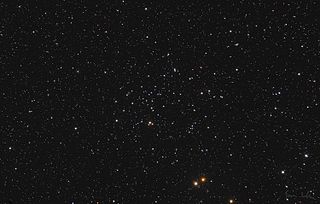
QX Andromedae is an eclipsing binary in the constellation Andromeda. It varies from a maximum apparent visual magnitude of 11.28 to a minimum of 11.50. Since it is impossible to specify the onset time of the eclipses, it is classified as a W Ursae Majoris variable star. It is also observed as an X-ray source and is a member of the open cluster NGC 752.

V455 Andromedae is a dwarf nova in the constellation Andromeda. It has a typical apparent visual magnitude of 16.5, but reached a magnitude of 8.5 during the only observed outburst.



















